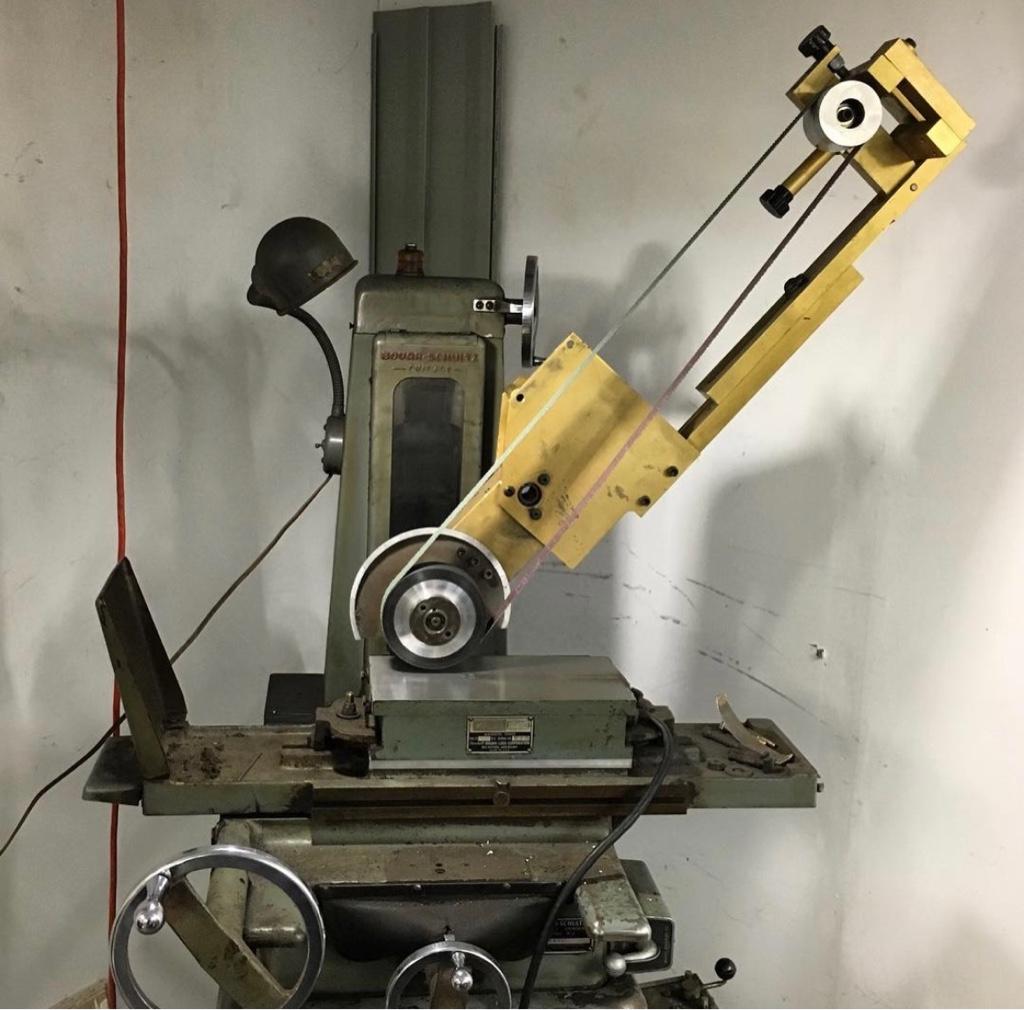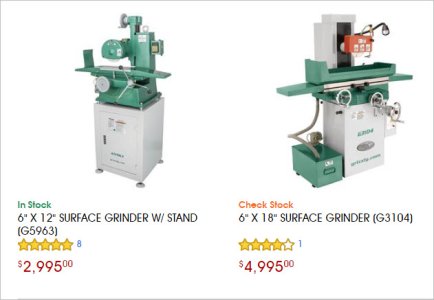Newby question. I was just curious about surface grinders vertical dial increment (depth of cut) on typical offshore machines. Just pulled Grizzly as example. According to the feature sheet docs, the smaller one on left = 0.001, the spendy one on right is 0.0001-0.0002". Does 0.001" sound right? That sounds rather course unless there is some independent tenths reading dial? What is the typical norm for old school USA or Euro iron?
-
Scam Alert. Members are reminded to NOT send money to buy anything. Don't buy things remote and have it shipped - go get it yourself, pay in person, and take your equipment with you. Scammers have burned people on this forum. Urgency, secrecy, excuses, selling for friend, newish members, FUD, are RED FLAGS. A video conference call is not adequate assurance. Face to face interactions are required. Please report suspicions to the forum admins. Stay Safe - anyone can get scammed.
-
Several Regions have held meetups already, but others are being planned or are evaluating the interest. The Calgary Area Meetup is set for Saturday July 12th at 10am. The signup thread is here! Arbutus has also explored interest in a Fraser Valley meetup but it seems members either missed his thread or had other plans. Let him know if you are interested in a meetup later in the year by posting here! Slowpoke is trying to pull together an Ottawa area meetup later this summer. No date has been selected yet, so let him know if you are interested here! We are not aware of any other meetups being planned this year. If you are interested in doing something in your area, let everyone know and make it happen! Meetups are a great way to make new machining friends and get hands on help in your area. Don’t be shy, sign up and come, or plan your own meetup!
You are using an out of date browser. It may not display this or other websites correctly.
You should upgrade or use an alternative browser.
You should upgrade or use an alternative browser.
Surface grinder vertical DOC specs
- Thread starter PeterT
- Start date
Tom Kitta
Ultra Member
On my SG there are to wheels both for down / up and for forward back. The coarse wheel advances 0.001 and the fine wheels divide this by 10 so you can adjust by just 0.0001. This way I can quickly move the head up and down - I think one full movement is like 250 or more and when I get there I can switch to "fine tune" mode.
Chipper5783
Super User
My Ingar has graduation on the vertical handwheel of 0.0005". They are spaced far enough apart that it is easy to split that in half again. Hitting 0.0001" reliably right off the dial would be a trick. I can work it out to 0.0002" (that is about the limit of what I can reliably measure anyway).
@PeterT while the above responses are helpful about typical SGs, this particular unit is graduated in .001, not .0001.
You can reasonably split the .001 into about thirds by being careful, (As @Chipper5783 suggests) but there is no vernier or multiplier dial. This is a good indication that it isn't a high quality or super accurate machine. With huge savings over the more accurate one, it speaks to setting a lower expectation.
You can reasonably split the .001 into about thirds by being careful, (As @Chipper5783 suggests) but there is no vernier or multiplier dial. This is a good indication that it isn't a high quality or super accurate machine. With huge savings over the more accurate one, it speaks to setting a lower expectation.
Thanks Dabbler. I never really looked hard at these entry level grinders, was just curious. I just 'assumed'.... often a dangerous proposition with some of these machines.
Maybe installing an accurate secondary dial is a possibility, but without knowing much more feels bit of kludgey trying to compensate for coarse leadscrew/gearing.
I'll have to check out some parts manuals, now my interest is kind of peaked how this is achieved on the big boy machines.
Maybe installing an accurate secondary dial is a possibility, but without knowing much more feels bit of kludgey trying to compensate for coarse leadscrew/gearing.
I'll have to check out some parts manuals, now my interest is kind of peaked how this is achieved on the big boy machines.
Chipper5783
Super User
PeterT, do you have a surface grinder? What sort of results are you getting?
An important aspect of surface grinding (and nearly every other aspect of work shop activity) is the skill of the operator. A capable operator, working with that "entry level grinder" can produce excellent results. Give that same person a really good grinder and the results may only be slightly better, but they'll be able to accomplish it faster. Provide that same high end surface grinder to a rookie - and the results probably won't be much better than if they had a POS grinder. Like everything else we do, grinding is somewhat of an art.
100-200 years ago, people were achieving incredible results using equipment and tool that were vastly inferior to the cheapest tools that we have today - there was a greater reliance on the skill of the person and they spent a lot more time.
My SG is nothing special, but there is no doubt that the skill of the operator is the #1 short coming.
The graduation of 0.001" or 0.0001" really isn't that a big deal (a good hand, and suitable support equipment for precise measuring could probably turn out tenth results all day).
An important aspect of surface grinding (and nearly every other aspect of work shop activity) is the skill of the operator. A capable operator, working with that "entry level grinder" can produce excellent results. Give that same person a really good grinder and the results may only be slightly better, but they'll be able to accomplish it faster. Provide that same high end surface grinder to a rookie - and the results probably won't be much better than if they had a POS grinder. Like everything else we do, grinding is somewhat of an art.
100-200 years ago, people were achieving incredible results using equipment and tool that were vastly inferior to the cheapest tools that we have today - there was a greater reliance on the skill of the person and they spent a lot more time.
My SG is nothing special, but there is no doubt that the skill of the operator is the #1 short coming.
The graduation of 0.001" or 0.0001" really isn't that a big deal (a good hand, and suitable support equipment for precise measuring could probably turn out tenth results all day).
No, I don't have a surface grinder. I suppose I could add it to my 'one day' list.... along with TIG welder, heat treat oven .... you get the idea. HaHa. I'm sure its like many things, once you have one, you find more uses & wonder how you did without. But on a realistic personal need basis for projects in my immediate que, there are probably other priorities & no free time to commit to a refurb project even if it was a good deal. I've watched a lot of YouTubes on them, mostly old school iron.
Man I use a boost Schultz 612, but I converted it to run 2x72” belts as my grinder all run. When I’m doing removal with an 80 grout ceramic belt .010 is a light cut. I can hog off about .018 before noticing any strain on the 1hp 220v motor. But back to your question, with a properly dressed stone, on these small grinder you can easily remove .002 per pass, with the right set up.
Sent from my iPhone using Tapatalk
Sent from my iPhone using Tapatalk
Chipper5783
Super User
Converted the surface grinder to use belts? Sounds pretty cool, please post pictures.
Sure!! I kinda threw it together with parts I had kicking around but it works like a treat!
Sent from my iPhone using Tapatalk

Sent from my iPhone using Tapatalk
Gosh, I’m having a hell of a time. I had a buddy make me a 5” 90 durrometer wheel with the matching inner bore to mate with the grinder’s original stone wheel bore. You really need to use a super hard wheel for this application. 70 durrometer is just too soft and will not give you the results your after.
Sent from my iPhone using Tapatalk
Sent from my iPhone using Tapatalk

